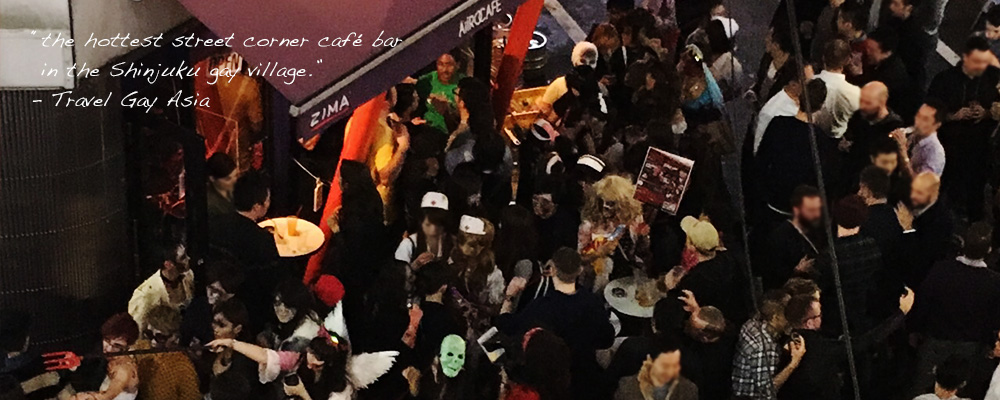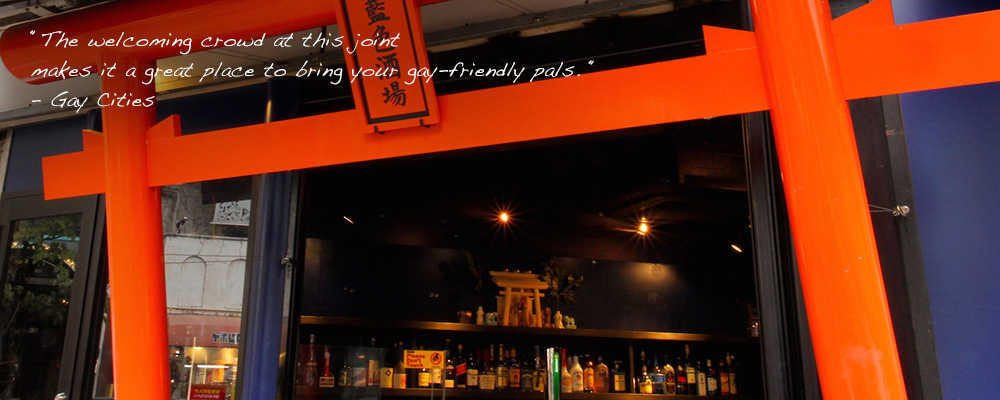新宿二丁目 Shinjuku nichome
Wherever you may be around the world, it is rare to find so many gay bars nestled in one area like Shinjuku Nichome. Mainly, they are bars for gay men, but also, some of them are for lesbians, straights and host-pubs, where good-looking, chic men will sit beside and entertain you - to enjoy drinking and have fun talking.
日本のゲイバー Japanese gay bars
Japanese gay bars are not very open to everyone.
There are about 500 bars in Shinjuku Nichome, 150 bars in Ueno, 100 bars in Shibuya and 50 bars in Asakusa.
Most of them are tiny bars and very unique.
First, you decide what kind of place you want to go and ask AiiRO CAFE staffs so they can give you advice on how and what to enjoy and how to get the best experience you want.
“What happens in Tokyo stays in Tokyo,” which I like it, but there is also an old Japanese proverb that goes, "If you are prepared, you don't have to worry.”
男色 Nanshoku
Nanshoku, which can also be read as danshoku, literally means “male colors.” The character 色(color) has the meaning for sexual pleasure in China and Japan. This term was widely used to refer to some kind of male-male sex in a pre-modern era of Japan. It is a culture from the Heian era. However since Meiji era, Nanshoku became something people hated.
Recently the word referring gay men as “Onee” is getting popular in Japanese media.But, actually, “Onee” and Gay have totally different definition.
ハッテン場 Hattenba
Hattenba is the place called a “Cruising Spot” or a “Sauna”. One of the meeting spot for gay men too.
着物 Kimono
Kimono is a traditional Japanese daily wardrobe since the Jomon era. There are certain rules and customs about wearing it. Kimonos have some variations though, like “Furisode,” worn by young women on special occasions, “Mofuku,” a kimono for mourning, “Irotomesode,” and a few more, and that has to be meticulously distinguished for appropriateness to certain occasions. For example, Dorozome (dyed with mud) from Amami-Oshima is an expensive Kimono, but it is not appropriate to wear on formal occasions. Kimono is a wardrobe that is based on the “WABISABI” culture in Japan.
If you have a chance to visit Kyoto, every month on the 21st, there is a flea market at the Toji temple that you can get used Kimono at a really reasonable price.
桜 SAKURA
During SAKURA season - usually from late March to early April, Japanese people go crazy and energetic. Sakura blossoms and the fine weather around that season make people so happy that they use it as an excuse to view sakura while getting wild and drunk.
Sakura is used in various ways - as an ingredient in cooking or a tint for painting, not just for viewing.
武士/侍 Bushi/Samurai
A lot of people from around the world say “TEMPURA!” “Fujisan!” “Chonmage!” “SAMURAI!”Yes! Samurai is one of the symbols of Japanese culture.
According to the social system in the old days, Samurai was refer to middle class people.There is a saying that ”No mercy for Bushi/SAMURAI”. It means Samurai and Bushi were always facing a life and death situation and they always needed to have curtsey and think about people around them. You can see “Omotenashi” spirit, caring for others in Bushi spirit.
漫画 Manga
Manga is just a part of the rich Japanese culture which we are proud of.
The legends, Osamu Teduka, Hayao Miyazaki, Fujio Akatsuka and Fujio Fujiko have built a great legacy of Manga culture in Japan. Manga lovers are separated into several types. Some of them are called Otaku, they like to gather in Akihabara, (some people call it as sacred spot for Otaku), others are in to Cosplay, they dress up as their favorite anime character and others like to publish comics by themselves which feature their favorite anime. In Shinjuku Nichome, Anime/Manga culture is popular, too. Especially after year 2000, the stereotype idea of “Anime is only for Otaku”, has changed, that there are more Anime/Manga lovers among gay.
浅草 Asakusa
Asakusa, also called “Shitamachi” (downtown), depicts the ancient Japanese culture that reflects in the people’s lives and the town. It was used to be called ”Jokamachi” , the town around the castle - in Japanese, we say, the town is below the castle to respect the lord. It was also the central area in Tokyo.
When you explore the town, you'll be able to find many historical buildings and stores selling traditional Japanese food and distinctive hand-made goods made by Shokunin (artisans) that you can purchase.
Ryotsu, the main character of a very famous cartoon ”Kochira Katsushika-ku Kamearikoen
mae Hasshutsujo” resides in Asakusa, that is why some Otaku call Asakusa, the ”sacred spot”.
Sensoji-temple is a symbol of Asakusa and it is a great place to Selfie!
Near Sensoji-temple, there is a Yoshoku restaurant called ”Yoshikami” where many Japanese comedians have gathered from a long time ago.
Every year, the end of May, the big festival called Sanjamatsuri is held in Asakusa. A lot of gays are excited to see the men in Fundoshi carrying Mikoshi on that day.
歌舞伎町 Kabukicho
Shinjuku ward is famous for these three spots, Kabukicho, Isetan department store and Shinjuku Nichome. In the past, Kabukicho was known for its gangs and prostitutes area that even Japanese people stay away from.
It has become a sightseeing area since it get a cleaner environment, and the popular store Don Quijote and big Gozzila stature on the hotel roof can be seen from the street and have become land marks of Kabukicho.
There is a very famous C-Male bar ”Hige Girl(Girls with mustache)” in Kabukicho.
ジブリ美術館 The Ghibli Museum
Since “Nausicaa of the Valley of the Wind”, Legend of Manga, Hayao Miyazaki has been offering us his fascinating and warm world.
The Ghibli Museum, as they have said, is where you can find the complete works of Miyazaki and you will be able to enjoy something “you have seen” while growing up - a nostalgia.
It is quite distant from the metropolis, so we recommend you to have a meal before going there.
After you have visited the world of Miyazaki, you can stop by Inogashira Park for a stroll. It is located near the museum . Taking a swan boat in the big pond may also be enjoyable.
築地市場 Tsukiji Fish Market
Tsukiji Fish Market is a great place to enjoy your breakfast. Tsukuji Fish Market is famous for its seafood but somehow Tamagoyaki(Japanese egg omelet) is one of the popular dishes there.
Recently the market has moved from Tsukiji area to a new place and developed a new style.
The hard working fishermen and male market vendors or clerks working there are so hot, with chiseled facial features and toned, muscular bodies, that will ignite your sexual fantasies. They are so muscular that they seem to be straight men, but, actually, some are gay - that, doesn’t matter whenever you started fueling your erotic desire.




